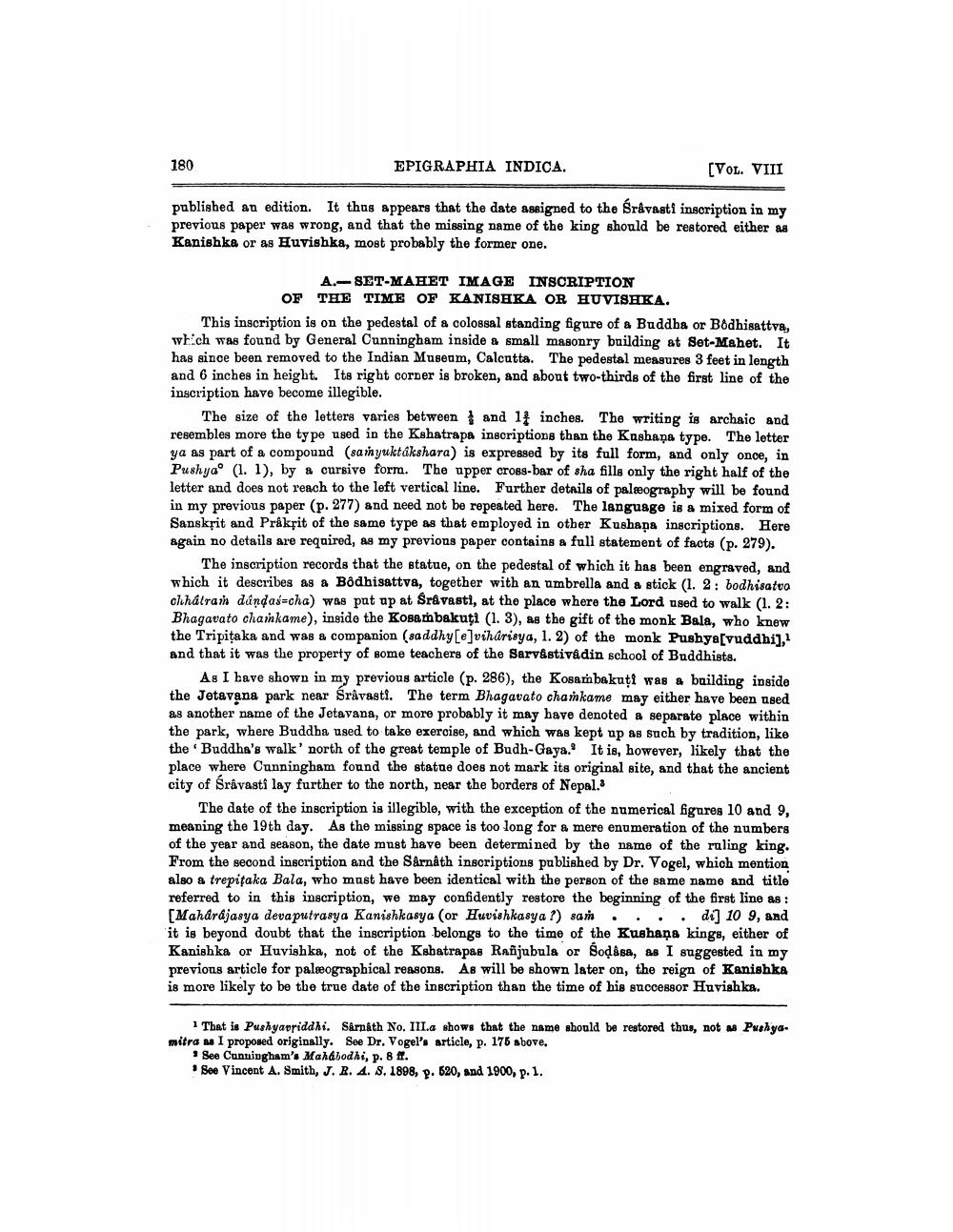________________
180
EPIGRAPHIA INDICA.
(VOL. VIII
published an edition. It thus appears that the date assigned to the Sravasti inscription in my previous paper was wrong, and that the missing name of the king should be restored either as Kanishka or as Huvishka, most probably the former one.
A.- SET-MAHET IMAGE INSCRIPTION
OF THE TIME OF KANISHKA OR HUVISHKA. This inscription is on the pedestal of a colossal standing figure of a Buddha or Bodhisattva, which was found by General Cunningham inside & small masonry building at Set-Mahet. It has since been removed to the Indian Museum, Calcutta. The pedestal measures 3 feet in length and 6 inches in height. Its right corner is broken, and about two-thirds of the first line of the inscription have become illegible.
The size of the letters varies between 1 and 14 inches. The writing is archaic and resembles more the type used in the Kshatrapa inscriptions than the Kasbaņa type. The letter ya as part of a compound (samyuktákshara) is expressed by its full form, and only once, in Pushyao (1.1), by a cursive form. The upper cross-bar of sha fills only the right half of the letter and does not reach to the left vertical line. Further details of palæography will be found in my previous paper (p. 277) and need not be repeated here. The language is a mixed form of Sanskțit and Prakrit of the same type as that employed in other Kushapa inscriptions. Here again no details are required, as my previons paper contains a full statement of facts (p. 279).
The inscription records that the statue, on the pedestal of which it has been engraved, and which it describes as a Bodhisattva, together with an umbrella and a stick (1. 2: bodhisatvo chhatran dúndas-cha) was put up at Sråvasti, at the place where the Lord used to walk (1. 2: Bhagavato chankame), inside the Kosambakuti (1. 3), as the gift of the monk Bala, who know the Tripitaka and was a companion (saddhy[e]viharisya, 1. 2) of the monk Pushya[vuddhi), and that it was the property of some teachers of the Sarvâstivadin school of Buddhists.
As I have shown in my previous article (p. 286), the Kosambakutt was a building inside the Jetavana park near Srâvasti. The term Bhagavato cha nkame may either have been used as another name of the Jetavana, or more probably it may have denoted a separate place within the park, where Buddha used to take exercise, and which was kept up as such by tradition, like the Buddha's walk' north of the great temple of Budh-Gaya. It is, however, likely that the place where Cunningham found the statue does not mark its original site, and that the ancient city of Sravasti lay further to the north, near the borders of Nepal.
The date of the inscription is illegible, with the exception of the numerical figures 10 and 9, meaning the 19th day. As the missing space is too long for a mere enumeration of the numbers of the year and season, the date must have been determined by the name of the ruling king. From the second inscription and the Sarnath inscriptions published by Dr. Vogel, which mention also a trepitaka Bala, who must have been identical with the person of the same name and title referred to in this inscription, we may confidently restore the beginning of the first line as : [Maharajasya deva putrasya Kanishkasya (or Huvishkasya ?) sam . . . . d1) 10 9, and it is beyond doubt that the inscription belongs to the time of the Kushana kings, either of Kanishka or Huvishka, not of the Kshatrapas Rañjubula or Sodasa, as I suggested in my previous article for paleographical reasons. As will be shown later on, the reign of Kanishka is more likely to be the true date of the inscription than the time of his successor Huvishka.
1 That is Pushyadriddhi. Sarnath No. III.a shows that the name should be restored thus, not u Prahya. mitra m I proposed originally. See Dr. Vogel's article, p. 176 above,
* See Cunningham's Mahabodhi, p. 8 fr.
See Vincent A. Smith, J. E. 4. 8. 1898, p. 620, snd 1900, p.1.




